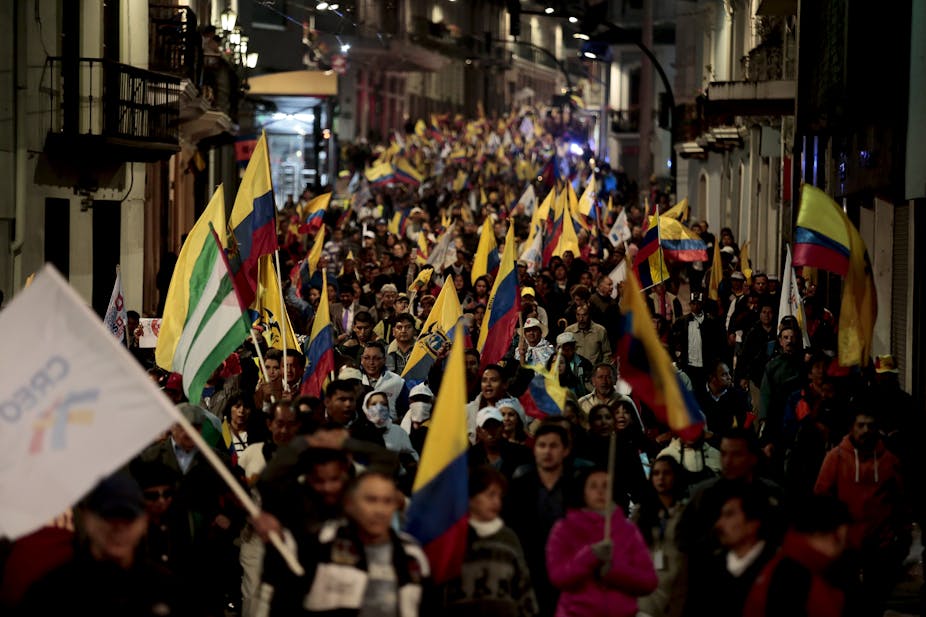Voters in Latin America appear to be tiring of its left wing leaders. In Argentina, the left-of-centre Victory Front coalition lost in 2015 against Let’s Change, a right-leaning alliance led by Mauricio Macri. In Brazil, the Workers’ Party was ousted from power in 2016 after 13 years following the impeachment of President Dilma Rousseff. In Bolivia, also in 2016, voters delivered a stinging defeat to President Evo Morales’ attempt to reform the constitution to run for a straight fourth term. In Venezuela, the PSUV lost the parliamentary elections and control of the National Assembly in 2015.
The April 2017 election in Ecuador, in which Lenin Moreno marginally secured the continuation of the “Citizen Revolution”, is the exception to the rule.
These results might appear to be a symptom of exhaustion with left leaning governments. Perhaps though, they are simply part of a cycle, in which leftist movements see a gradual slowing of support. Political scientist Sidney Tarrow used the phrase “cycle of contention” to identify a “phase of heightened conflict across the social system” which begins at a moment of disruption in society.
Key moments of disruption in South America which have sparked left wing movements are not hard to find. There were the violent “Caracazo riots” in Venezuela in 1989, against government market reforms resulting in higher oil prices. The “Cochabamba water wars” in Bolivia in 2000, involved a series of protests against the privatisation of the municipal water supply in the country’s third largest city. In December 2001 Argentina saw a nationwide revolt against deepening austerity policies in the context of a long economic recession. The “forajidos” (the outlaws) was the name given to a popular uprising in 2005 in Ecuador against president Gutiérrez (who was accused of betraying electoral campaigns of reform and alienating key political allies). These social protests represented a phase of heightened conflict that resulted in divided societies and polarised political representation.
From this point of view, the subsequent turns to the left represented a bottom-up movement of social upheaval rather than just populist leaders seeking power. The social unrest set the conditions for the left to take control and cement a new anti-neoliberal agenda in the region that lasted about 15 years. The novelty of the phenomenon was that unlike the left-wing projects of the 1970s, the left played by the rules of the democratic game and did it successfully – winning landslide elections.
But apart from in Ecuador (where since 2006 Rafael Correa won three presidential elections as leader of the Citizen’s Revolution), the left has since continued to lose control of governments in the region.

Yet while the political left is currently in a state of flux, a diverse and highly organised social activism remains active on the streets. A general strike was called in April in Brazil against Temer’s government and its reforms. The first of its kind in 20 years. In Argentina, thousands of teachers took to the streets of Buenos Aires demanding a wage increase.
Many voices
In addition, indigenous peoples, women, beneficiaries of social programmes, industrial trade union workers and civil servants, have all been loudly voicing their opposition to the dismantling of key public policies, as well as raising new demands.
So it is not correct to identify an “end” of the left leaning cycle in Latin America. Instead it is more appropriate to speak of a transition from electoral dominance to a socio-political standoff. As a consequence, there is a greater degree of fortune deciding the result of an elections. The marginal results seen in the recent elections in Brazil, Argentina and Ecuador are proof of that.
This means that the popular sector remains active and has enough political power to stage large strikes and moments of direct action. However there is no new element of unity because there are so many demands which are, in turn, demanded by different organisations – and the links between these different organisations remain weak. It also means that only a minority of these social sectors feel politically represented by, for instance, the Workers’ Party in Brazil or Kirchnerismo in Argentina.
Having a right-leaning government tends to facilitate the reorganisation of the popular sector because the adversary is more clearly identifiable and common to all. This is why the left’s momentum has reached a moment of crisis – but has not yet been deactivated.
On the contrary, having a progressive government in power just makes the reorganisation of the popular sector more complex. So far, only Ecuador has been successful in bucking the regional trend. But it remains unclear if this contributes to the necessary reorganisation of the left – or to deepening its crisis. For the time being at least, the Latin American left is in check, but not yet checkmated.

